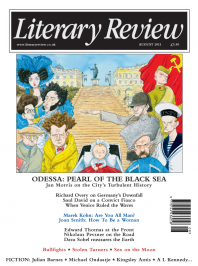William Doyle
Boom and Beast
Monsters of the Gévaudan: The Making of a Beast
By Jay M Smith
Harvard University Press 392pp £25.95
Wolves still roam wild today in the remoter corners of Europe, and their disappearance elsewhere remains just within living memory. In the eighteenth century their depredations were a routine hazard of rural life. The king of France’s wolfhounds were kept busy hunting them down until the French Revolution. The main danger from wolves was to livestock, but isolated and relatively defenceless human beings, such as young shepherds, could also be at risk. Nevertheless, attacks on people were rare, so that when, in the mid-1760s, over 100 children and young women were brutally torn to pieces in a wild and impoverished region in the eastern slopes of the Massif Central, it was easy to believe that something worse than a wolf was responsible. The killings were soon attributed to a unique and terrifying ‘beast’ whose savagery was only matched by its elusiveness. Several overconfident sweeps by experienced hunters failed to track it down until, after months of frustration and continued attacks, one of them shot a particularly large wolf. Its remains were sent to Versailles for the king and his courtiers to inspect, and the hunt for the Beast of the Gévaudan was declared to be over.
Yet attacks on humans by wolves went on, though with diminishing frequency, and not only in the Gévaudan. What, then, gave this particular episode such resonance, both at the time and in later popular memory? The fame of the beast spread across Europe and even the

Sign Up to our newsletter
Receive free articles, highlights from the archive, news, details of prizes, and much more.@Lit_Review
Follow Literary Review on Twitter
Twitter Feed
How to ruin a film - a short guide by @TWHodgkinson:
Thomas W Hodgkinson - There Was No Sorcerer
Thomas W Hodgkinson: There Was No Sorcerer - Box Office Poison: Hollywood’s Story in a Century of Flops by Tim Robey
literaryreview.co.uk
How to ruin a film - a short guide by @TWHodgkinson:
Thomas W Hodgkinson - There Was No Sorcerer
Thomas W Hodgkinson: There Was No Sorcerer - Box Office Poison: Hollywood’s Story in a Century of Flops by Tim Robey
literaryreview.co.uk
Give the gift that lasts all year with a subscription to Literary Review. Save up to 35% on the cover price when you visit us at https://literaryreview.co.uk/subscribe and enter the code 'XMAS24'